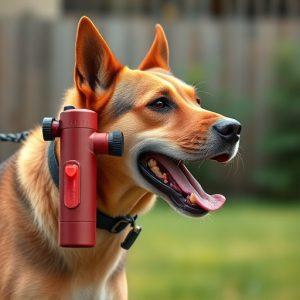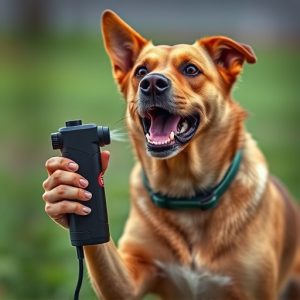Pepper Spray for Dog Control: Legalities, Science, and Safe Use
Pepper spray tailored for dog control offers a non-lethal solution for managing aggressive canine be…….
Pepper spray tailored for dog control offers a non-lethal solution for managing aggressive canine behavior, utilizing capsaicin to temporarily disable dogs and provide safe intervention time. Legal usage varies globally, with regulations governing spray type, strength, and deployment conditions, focusing on public safety and controlled response. Tailored canine-specific formulations, proper training, understanding local laws, and correct application technique enhance the effectiveness of pepper spray while minimizing risks. Case studies demonstrate its success in de-escalating high-risk situations and protecting vulnerable individuals, making it a valuable tool for animal control and public safety.
“Unleashing control with a legal and effective solution, pepper spray emerges as a powerful tool in managing aggressive dogs. This comprehensive guide explores the science behind its formulation, offering insights into its effectiveness against canine aggression. We navigate the legal framework governing its use, ensuring responsible application techniques for optimal results. From real-world case studies to safety considerations, discover how pepper spray can be a game-changer in dog control while learning best practices to minimize risk.”
- Understanding Pepper Spray for Dog Control: Legal Framework and Regulations
- The Science Behind Pepper Spray Formulations: Effectiveness Against Dogs
- Safe Use and Application Techniques: Ensuring Efficiency and Minimizing Risk
- Case Studies: Real-World Applications and Their Outcomes
Understanding Pepper Spray for Dog Control: Legal Framework and Regulations
Pepper spray, formulated specifically for dog control, has gained attention as a non-lethal tool to manage aggressive canine behavior. This type of spray is designed to temporarily incapacitate a dog, providing handlers with enough time to safely restrain or evacuate the animal from potentially dangerous situations. The legal framework surrounding its use varies across jurisdictions, with some regions permitting it for specific purposes, such as by law enforcement or trained professionals in emergency scenarios.
Regulations often dictate the type of pepper spray allowed, its strength, and the conditions under which it can be deployed. Typically, these laws aim to ensure public safety while also recognizing the potential benefits of a controlled, non-fatal response when dealing with aggressive dogs. Understanding these legal parameters is crucial for individuals or organizations considering the implementation of pepper spray as a last resort in dog control measures, especially given the varying degrees of regulation and permitted use across different communities.
The Science Behind Pepper Spray Formulations: Effectiveness Against Dogs
The science behind pepper spray formulations is a fascinating blend of chemistry and behavior studies. These products are designed to target specific physiological systems in animals, particularly dogs known for their aggression. The key active ingredient in many pepper sprays used against aggressive dogs is capsaicin, the compound responsible for the heat sensation in chili peppers. When sprayed onto the eyes and face, capsaicin irritates nerve endings, temporarily disrupting balance and vision. This disruption creates a temporary but effective deterrence, giving individuals time to retreat or defuse potentially dangerous situations.
Research has shown that properly formulated pepper sprays can significantly reduce aggressive dog behavior. The spray’s ability to cause discomfort and disorient the animal without causing serious harm makes it a valuable tool for self-defense in areas where dog encounters pose a risk. Moreover, advancements in pepper spray technology have led to formulations tailored for canine behavior, ensuring higher effectiveness and safety when used as directed.
Safe Use and Application Techniques: Ensuring Efficiency and Minimizing Risk
When using animal control spray, especially pepper spray designed for aggressive dogs, it’s paramount to prioritize safety and efficiency. The right application technique can significantly enhance its effectiveness while minimizing potential risks to users and bystanders. Start by ensuring proper training in the use of such devices, understanding local laws, and selecting a product from reputable manufacturers that meets specific requirements, like those outlined for pepper spray formulations against aggressive dogs.
During application, maintaining a safe distance is crucial. Users should aim for the eyes, nose, and mouth—sensitive areas on a dog’s face—while keeping their hands protected with gloves. A swift and controlled spray ensures the solution reaches its target accurately without causing unnecessary harm or spreading to unwanted areas. Regular maintenance of the spray device, including checking expiration dates and proper storage, is also vital for safety and optimal performance.
Case Studies: Real-World Applications and Their Outcomes
In real-world applications, pepper spray formulations have proven effective in managing aggressive dog encounters. Case studies show that when used appropriately, these sprays can de-escalate high-risk situations without causing lasting harm to the animals. For instance, in urban areas with high dog populations, pepper spray has been successfully employed by animal control officers to stop unprovoked attacks on both humans and other pets. One such case involved a known aggressive dog that had bitten multiple individuals in a residential neighborhood. Upon receiving a report, an animal control team equipped with specialized pepper spray was able to quickly subdue the canine without the need for lethal force, preventing further injuries and allowing for safe removal of the animal.
Another study highlighted its use in protecting vulnerable individuals, such as postal workers or delivery personnel, who frequently interact with dogs in diverse environments. In this scenario, a pepper spray gun was utilized to stop an out-of-control dog that had chased and attempted to attack a mail carrier. The rapid deployment of the spray temporarily blinded the dog, enabling the worker to escape unharmed. This demonstrates the strategic role of pepper spray in animal control, offering a non-lethal yet potent solution for both public safety and the welfare of at-risk animals.
In conclusion, pepper spray for dog control, specifically tailored to address aggressive canine behavior, presents a legal and effective solution. The article has explored the scientific basis of these formulations, safe application methods, and real-world case studies demonstrating their success. By understanding the legal framework and adhering to responsible use guidelines, individuals can effectively manage potentially dangerous dogs while ensuring the safety of humans and other pets. The safe and strategic deployment of pepper spray remains a valuable tool in navigating challenging canine situations.


